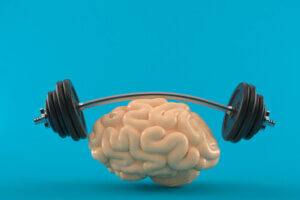Is the Mind-Body Connection Important?

Many people seem to underestimate the importance of the mind-body connection when it comes to achieving a better performance. Despite the fact that we often allow its influence to go unnoticed, it’s something that’s always present.
We understand the mind-body connection to be the relationship between the mental processes and how the muscles work. Alternatively, we can explain it as the union of the nervous system and the musculoskeletal system. This is a two-way relationship; the brain sends signals that affect the muscles, but the physical sensations the body feels also have the power to influence the mind.
The importance of this connection comes from the fact that it directly intervenes in the process of muscle contraction and relaxation. Additionally, it has a primordial role in healing from injuries, similar to proprioception. This is the body’s awareness of position, posture, movement, and changes. Below, we take a look at what the mind-body connection is all about and why it’s so important.
The mind-body connection: what is it?
As we mentioned above, the mind-body connection is the union between the nervous system and the muscles. On the most basic level, it’s the relationship between neurons and muscle fibers or tendons. This has an important role when it comes to mobility and sensation.
There are 2 main structures that perfectly represent the mind-body connection. And, they are as follows:
- Neuromuscular spindle: this is a stretching receptor that we can find in the majority of musculoskeletal systems made by fibers wrapped in nerve endings. When the nerves detect that a muscle overstretched, the spindle reacts with a myotatic reflex, a quick and brisk contraction in the hope to avoid injury.
- Golgi tendon organ: situated in the union between the muscle and the tendon, this organ plays a fundamental role in the prevention of injuries. When the muscle excessively contracts, the Golgi tendon organ activates and transmits the painful information to the spinal cord.

Why is the mind-body connection so important?
Once you understand what the mind-body connection is, the next step is to dig a little deeper into why it’s so important for sporting performance.
1. It plays a fundamental role in avoiding injuries
Above, we hinted that the main function of the mind-body connection is to prevent injuries. The sensation of pain that our muscles produce is a signal that something isn’t going well. It’s our bodies’ way of advising us to stop or warning us that we’re not doing an exercise correctly.
If our muscles didn’t end in nerve endings, we wouldn’t be able to protect ourselves; we’d end up hurting ourselves more frequently, and they’d be more serious and long-lasting.
For that reason, you should never ignore any pain that you feel after training or after doing certain exercises. Unfortunately, a few people have a dangerous belief that pain is a signal that you’re working hard, but that couldn’t be further from the truth. Ignoring it only increases your chances of hurting yourself.
2. It’s an essential part of your balance and body position
Proprioception informs you about your body position in a determined space. This sense stretches to maintain balance, coordination, and spatial awareness.
The mind-body connection plays a huge part in the proprioception system. The electric impulses that generate in the neuromuscular spindle and in the Golgi tendon organ go to the brain. The brain then processes and organizes all the sensations related to the muscle positions.
In fact, it’s very common for your body to work proprioceptively when it comes to healing injuries. According to a study published in the International Journal for Medicine and the Science of Physical Activities and Sport (Revista Internacional de Medicina y Ciencias de la Actividad Física y del Deporte), proprioception is an efficient tool during the rehabilitation process after knee surgery.
3. It favors muscular control and coordination
One of the advantages of focusing on working on the mind-body connection si that it can help you to better control your movements.

Coordination is all about a correct synchronization between the orders the brain sends and the movements the body does. This synchronization is fundamental to do movements with fluidity and precision, and even more so when you try to learn new motor skills. This is because you have to acquire coordination bit by bit.
Don’t forget to work on your mind-body connection
Although this relationship between neurons and muscles is something quite technical and specific, you can actually train it anywhere without specific equipment. When it comes to proprioception, there are specific tools you need to strengthen it, like bosu balls or foam noodles.
However, you can also train this ability by adding instability, like holding your weight on one leg. Now you know: in order to prevent injuries and improve your sporting performance, remember what we told you in this article!
Many people seem to underestimate the importance of the mind-body connection when it comes to achieving a better performance. Despite the fact that we often allow its influence to go unnoticed, it’s something that’s always present.
We understand the mind-body connection to be the relationship between the mental processes and how the muscles work. Alternatively, we can explain it as the union of the nervous system and the musculoskeletal system. This is a two-way relationship; the brain sends signals that affect the muscles, but the physical sensations the body feels also have the power to influence the mind.
The importance of this connection comes from the fact that it directly intervenes in the process of muscle contraction and relaxation. Additionally, it has a primordial role in healing from injuries, similar to proprioception. This is the body’s awareness of position, posture, movement, and changes. Below, we take a look at what the mind-body connection is all about and why it’s so important.
The mind-body connection: what is it?
As we mentioned above, the mind-body connection is the union between the nervous system and the muscles. On the most basic level, it’s the relationship between neurons and muscle fibers or tendons. This has an important role when it comes to mobility and sensation.
There are 2 main structures that perfectly represent the mind-body connection. And, they are as follows:
- Neuromuscular spindle: this is a stretching receptor that we can find in the majority of musculoskeletal systems made by fibers wrapped in nerve endings. When the nerves detect that a muscle overstretched, the spindle reacts with a myotatic reflex, a quick and brisk contraction in the hope to avoid injury.
- Golgi tendon organ: situated in the union between the muscle and the tendon, this organ plays a fundamental role in the prevention of injuries. When the muscle excessively contracts, the Golgi tendon organ activates and transmits the painful information to the spinal cord.

Why is the mind-body connection so important?
Once you understand what the mind-body connection is, the next step is to dig a little deeper into why it’s so important for sporting performance.
1. It plays a fundamental role in avoiding injuries
Above, we hinted that the main function of the mind-body connection is to prevent injuries. The sensation of pain that our muscles produce is a signal that something isn’t going well. It’s our bodies’ way of advising us to stop or warning us that we’re not doing an exercise correctly.
If our muscles didn’t end in nerve endings, we wouldn’t be able to protect ourselves; we’d end up hurting ourselves more frequently, and they’d be more serious and long-lasting.
For that reason, you should never ignore any pain that you feel after training or after doing certain exercises. Unfortunately, a few people have a dangerous belief that pain is a signal that you’re working hard, but that couldn’t be further from the truth. Ignoring it only increases your chances of hurting yourself.
2. It’s an essential part of your balance and body position
Proprioception informs you about your body position in a determined space. This sense stretches to maintain balance, coordination, and spatial awareness.
The mind-body connection plays a huge part in the proprioception system. The electric impulses that generate in the neuromuscular spindle and in the Golgi tendon organ go to the brain. The brain then processes and organizes all the sensations related to the muscle positions.
In fact, it’s very common for your body to work proprioceptively when it comes to healing injuries. According to a study published in the International Journal for Medicine and the Science of Physical Activities and Sport (Revista Internacional de Medicina y Ciencias de la Actividad Física y del Deporte), proprioception is an efficient tool during the rehabilitation process after knee surgery.
3. It favors muscular control and coordination
One of the advantages of focusing on working on the mind-body connection si that it can help you to better control your movements.

Coordination is all about a correct synchronization between the orders the brain sends and the movements the body does. This synchronization is fundamental to do movements with fluidity and precision, and even more so when you try to learn new motor skills. This is because you have to acquire coordination bit by bit.
Don’t forget to work on your mind-body connection
Although this relationship between neurons and muscles is something quite technical and specific, you can actually train it anywhere without specific equipment. When it comes to proprioception, there are specific tools you need to strengthen it, like bosu balls or foam noodles.
However, you can also train this ability by adding instability, like holding your weight on one leg. Now you know: in order to prevent injuries and improve your sporting performance, remember what we told you in this article!
All cited sources were thoroughly reviewed by our team to ensure their quality, reliability, currency, and validity. The bibliography of this article was considered reliable and of academic or scientific accuracy.
- Álvarez, J. R., López-Silvarrey, F. J., Martínez, J. S., Melen, H. M., y Arce, J. L. (2008). Rehabilitación del paciente con lesión del ligamento cruzado anterior de la rodilla (LCA). Revisión. Revista Internacional de Medicina y Ciencias de la Actividad Física y del Deporte/International Journal of Medicine and Science of Physical Activity and Sport, 8(29), 62-92.
This text is provided for informational purposes only and does not replace consultation with a professional. If in doubt, consult your specialist.








